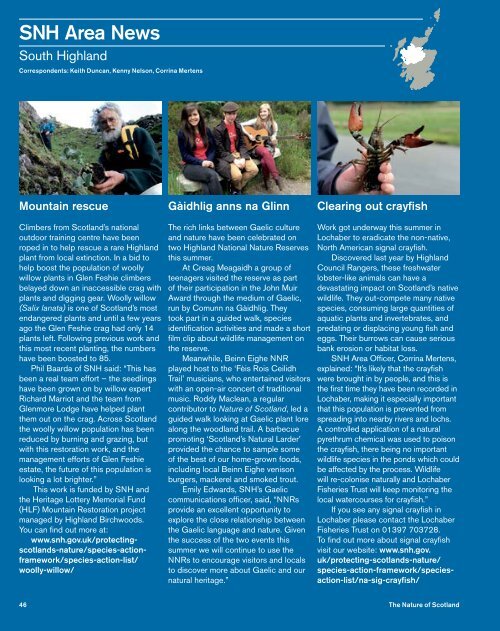The Nature of Scotland
The Nature of Scotland
The Nature of Scotland
You also want an ePaper? Increase the reach of your titles
YUMPU automatically turns print PDFs into web optimized ePapers that Google loves.
SNH Area News<br />
South Highland<br />
Correspondents: Keith Duncan, Kenny Nelson, Corrina Mertens<br />
Mountain rescue<br />
Climbers from <strong>Scotland</strong>’s national<br />
outdoor training centre have been<br />
roped in to help rescue a rare Highland<br />
plant from local extinction. In a bid to<br />
help boost the population <strong>of</strong> woolly<br />
willow plants in Glen Feshie climbers<br />
belayed down an inaccessible crag with<br />
plants and digging gear. Woolly willow<br />
(Salix lanata) is one <strong>of</strong> <strong>Scotland</strong>’s most<br />
endangered plants and until a few years<br />
ago the Glen Feshie crag had only 14<br />
plants left. Following previous work and<br />
this most recent planting, the numbers<br />
have been boosted to 85.<br />
Phil Baarda <strong>of</strong> SNH said: “This has<br />
been a real team effort – the seedlings<br />
have been grown on by willow expert<br />
Richard Marriot and the team from<br />
Glenmore Lodge have helped plant<br />
them out on the crag. Across <strong>Scotland</strong><br />
the woolly willow population has been<br />
reduced by burning and grazing, but<br />
with this restoration work, and the<br />
management efforts <strong>of</strong> Glen Feshie<br />
estate, the future <strong>of</strong> this population is<br />
looking a lot brighter.”<br />
This work is funded by SNH and<br />
the Heritage Lottery Memorial Fund<br />
(HLF) Mountain Restoration project<br />
managed by Highland Birchwoods.<br />
You can find out more at:<br />
www.snh.gov.uk/protectingscotlands-nature/species-actionframework/species-action-list/<br />
woolly-willow/<br />
Gàidhlig anns na Glinn<br />
<strong>The</strong> rich links between Gaelic culture<br />
and nature have been celebrated on<br />
two Highland National <strong>Nature</strong> Reserves<br />
this summer.<br />
At Creag Meagaidh a group <strong>of</strong><br />
teenagers visited the reserve as part<br />
<strong>of</strong> their participation in the John Muir<br />
Award through the medium <strong>of</strong> Gaelic,<br />
run by Comunn na Gàidhlig. <strong>The</strong>y<br />
took part in a guided walk, species<br />
identification activities and made a short<br />
film clip about wildlife management on<br />
the reserve.<br />
Meanwhile, Beinn Eighe NNR<br />
played host to the ‘Fèis Rois Ceilidh<br />
Trail’ musicians, who entertained visitors<br />
with an open-air concert <strong>of</strong> traditional<br />
music. Roddy Maclean, a regular<br />
contributor to <strong>Nature</strong> <strong>of</strong> <strong>Scotland</strong>, led a<br />
guided walk looking at Gaelic plant lore<br />
along the woodland trail. A barbecue<br />
promoting ‘<strong>Scotland</strong>’s Natural Larder’<br />
provided the chance to sample some<br />
<strong>of</strong> the best <strong>of</strong> our home-grown foods,<br />
including local Beinn Eighe venison<br />
burgers, mackerel and smoked trout.<br />
Emily Edwards, SNH’s Gaelic<br />
communications <strong>of</strong>ficer, said, “NNRs<br />
provide an excellent opportunity to<br />
explore the close relationship between<br />
the Gaelic language and nature. Given<br />
the success <strong>of</strong> the two events this<br />
summer we will continue to use the<br />
NNRs to encourage visitors and locals<br />
to discover more about Gaelic and our<br />
natural heritage.”<br />
Clearing out crayfish<br />
Work got underway this summer in<br />
Lochaber to eradicate the non-native,<br />
North American signal crayfish.<br />
Discovered last year by Highland<br />
Council Rangers, these freshwater<br />
lobster-like animals can have a<br />
devastating impact on <strong>Scotland</strong>’s native<br />
wildlife. <strong>The</strong>y out-compete many native<br />
species, consuming large quantities <strong>of</strong><br />
aquatic plants and invertebrates, and<br />
predating or displacing young fish and<br />
eggs. <strong>The</strong>ir burrows can cause serious<br />
bank erosion or habitat loss.<br />
SNH Area Officer, Corrina Mertens,<br />
explained: “It’s likely that the crayfish<br />
were brought in by people, and this is<br />
the first time they have been recorded in<br />
Lochaber, making it especially important<br />
that this population is prevented from<br />
spreading into nearby rivers and lochs.<br />
A controlled application <strong>of</strong> a natural<br />
pyrethrum chemical was used to poison<br />
the crayfish, there being no important<br />
wildlife species in the ponds which could<br />
be affected by the process. Wildlife<br />
will re-colonise naturally and Lochaber<br />
Fisheries Trust will keep monitoring the<br />
local watercourses for crayfish.”<br />
If you see any signal crayfish in<br />
Lochaber please contact the Lochaber<br />
Fisheries Trust on 01397 703728.<br />
To find out more about signal crayfish<br />
visit our website: www.snh.gov.<br />
uk/protecting-scotlands-nature/<br />
species-action-framework/speciesaction-list/na-sig-crayfish/<br />
46 <strong>The</strong> <strong>Nature</strong> <strong>of</strong> <strong>Scotland</strong>
















